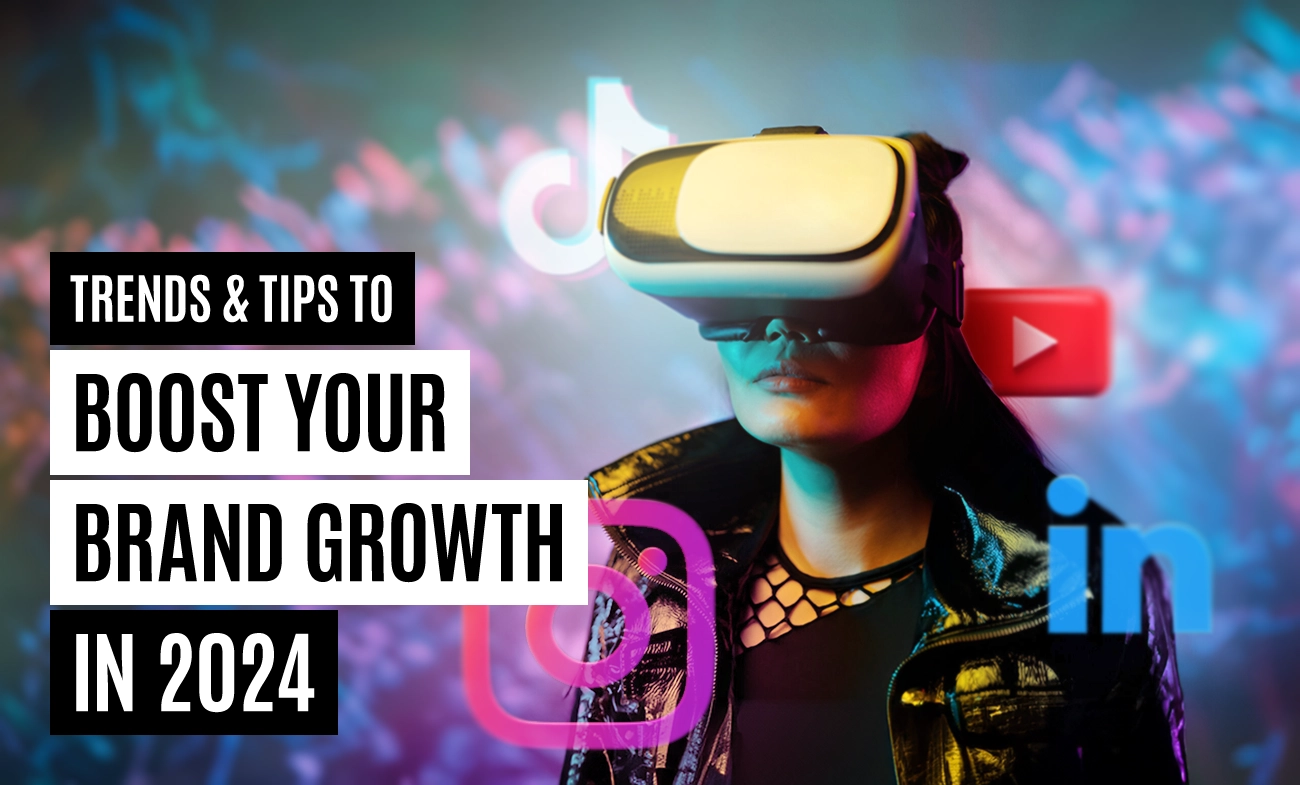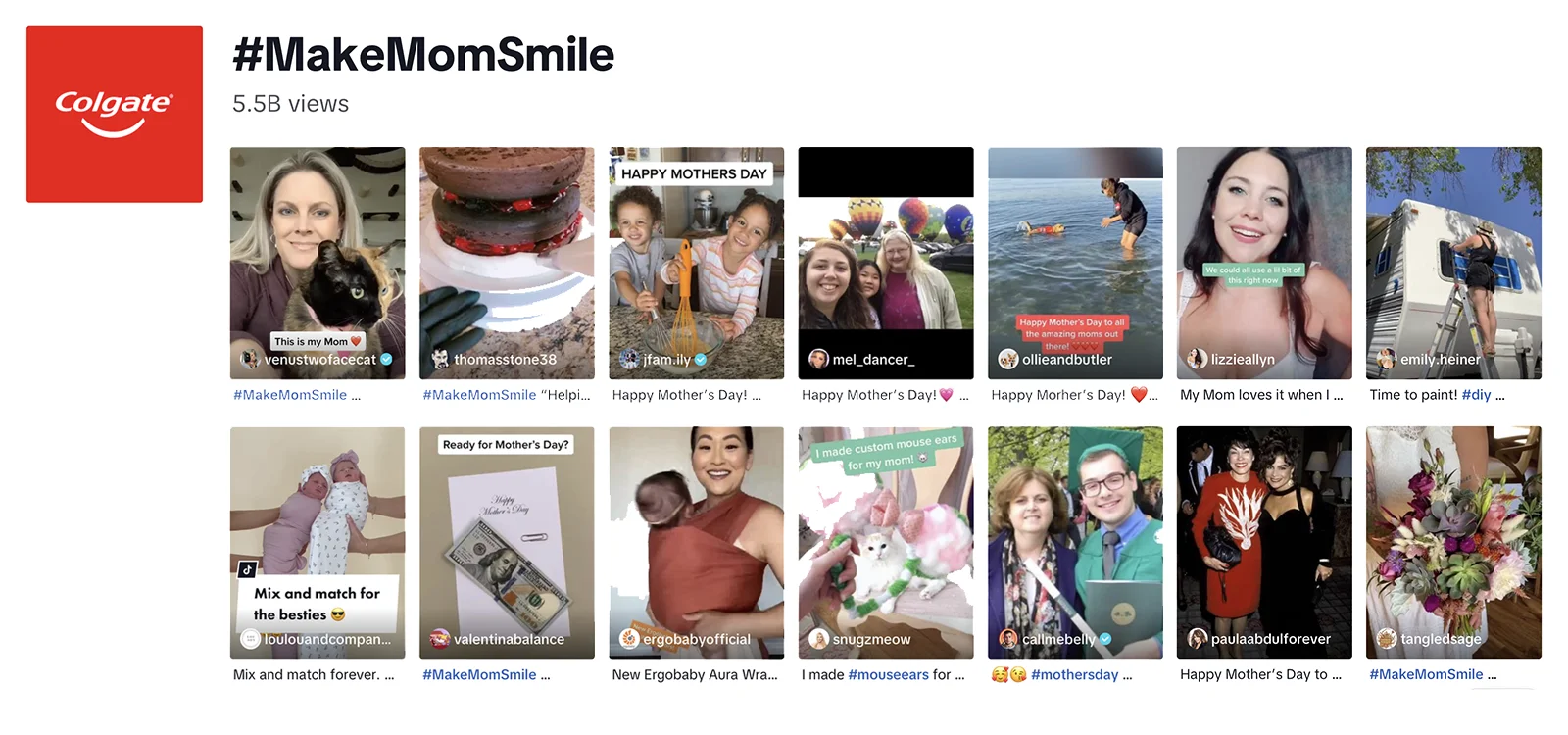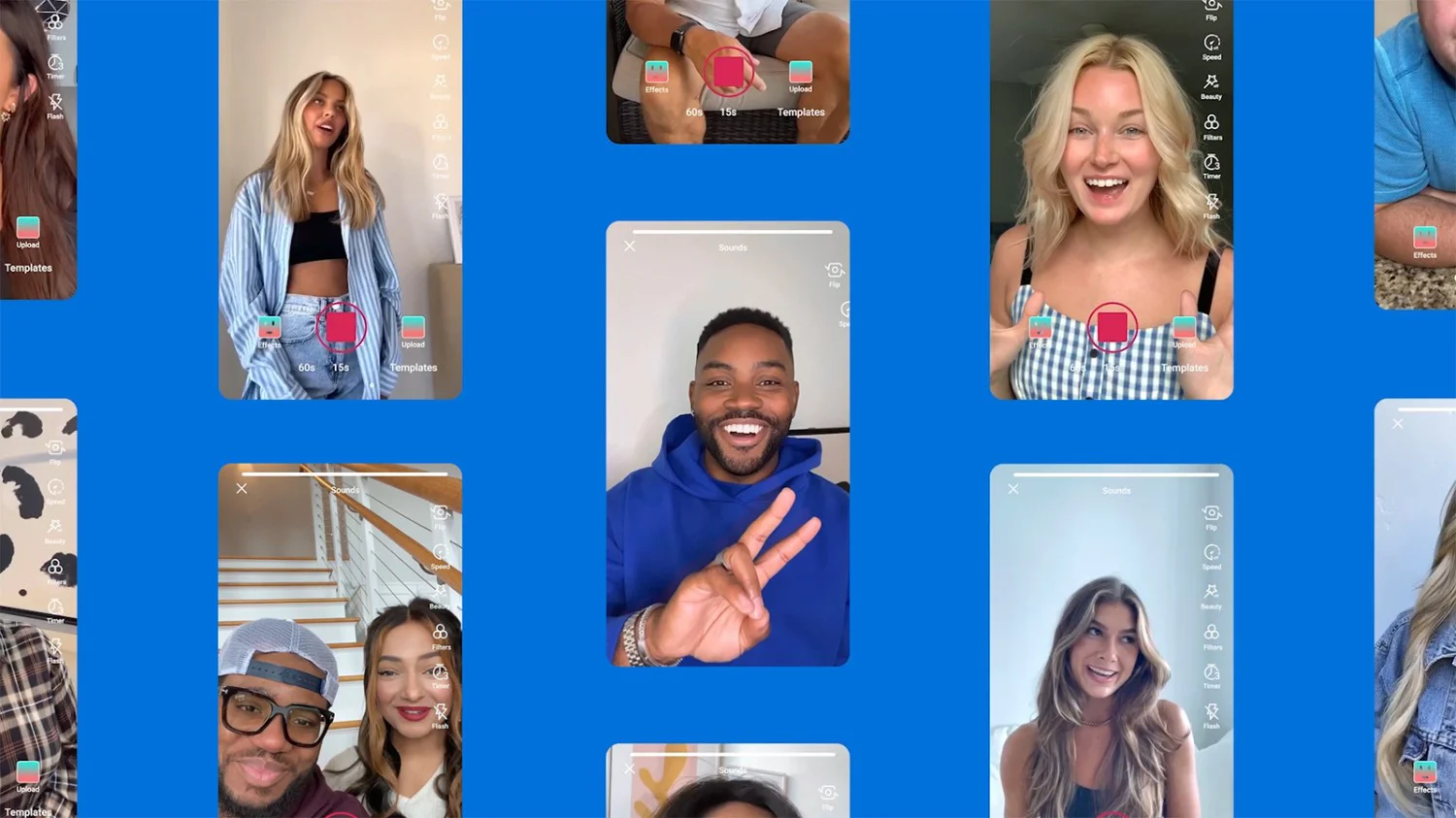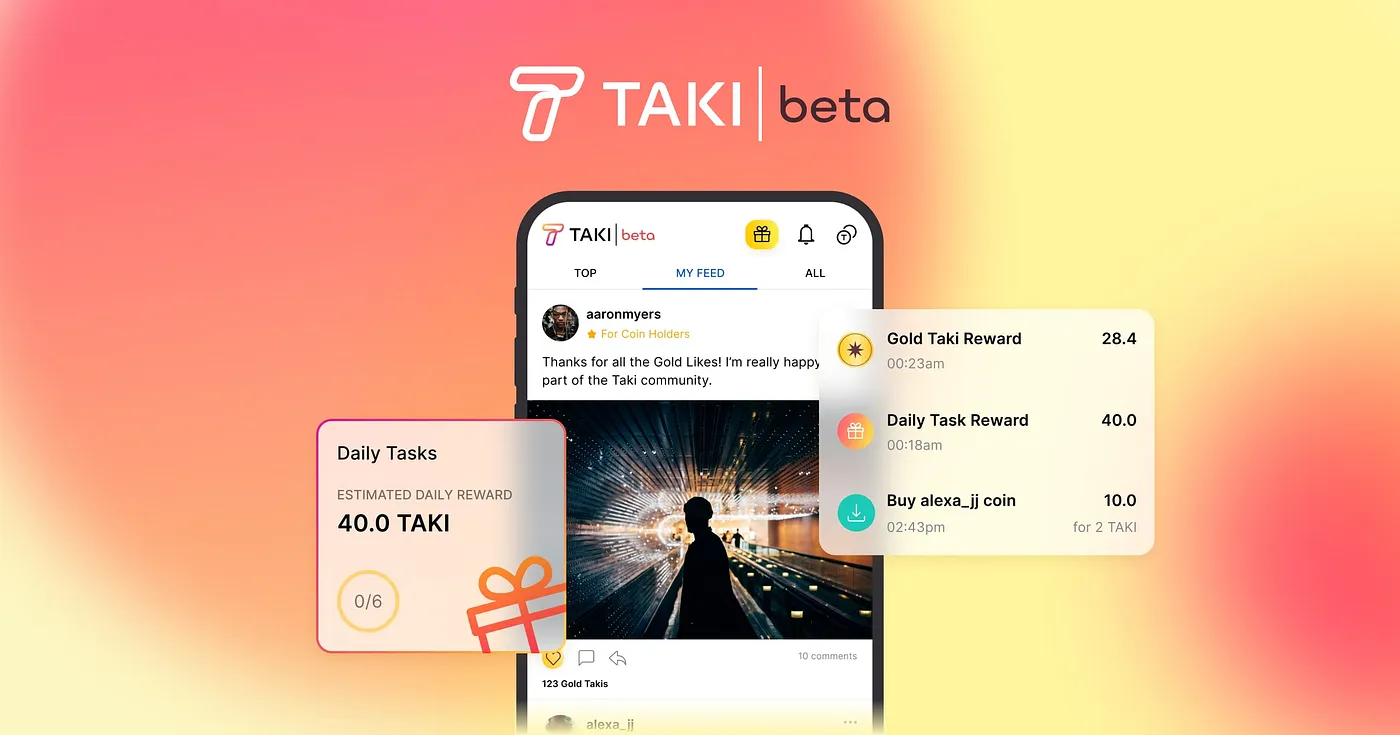
2024 Top Social Media Trends: Expert Tips & Inspiring Cases for Brand Growth
2024 is set to be a decisive year offering new opportunities for business growth. It’s time to level up your social media strategy to crack the algorithm and make your brand sparkle in the digital world. We’re here to guide you through the top social media trends, with easy-to-follow strategies and inspiring examples that will help your brand outshine the competition.
1. AI REVOLUTIONIZES CONTENT CREATION
AI’s integration into social media is accelerating, redefining content creation and consumer interactions. Generative AI stands out and is here to stay by offering diverse content production capabilities. For brands to thrive, adapting to this technology is crucial for better customer support, scalability, brand consistency and more creative content strategies.
EASY-TO-FOLLOW STRATEGIES
• Train Your AI System: Collect data that represents your brand voice and audience preferences. Use tools like Google Analytics and CRM systems (Exe: Pipedrive, HubSpot and Zendesk) to gather this data. Input it into your AI tool to train the model for content that aligns with your brand.
• Use Specific Prompts and Regular Revisions: Provide detailed prompts to your AI tool, specifying the topic, tone, and audience. After content generation, review and edit for accuracy, brand consistency, and quality.
• Implement Chatbots: Choose a chatbot service provider like ManyChat, Chatfuel, or Drift and customize it for your brand. Set up responses to common queries and integrate with your product database if needed. Deploy the chatbot on platforms where your audience is active, like Facebook Messenger.
REAL CASE EXAMPLES
• Sephora’s AI Chatbot: Sephora implemented an AI chatbot to assist shoppers overwhelmed by choices. The Sephora chatbot, acting as a digital beauty consultant, offers personalized advice and suggestions, resulting in an 11% higher conversion rate for booking in-store appointments compared to other channels.
• Heinz: In collaboration with Rethink Ideas, Heinz launched an ad campaign with visuals generated entirely by AI. They encouraged consumer participation in creating AI-generated ketchup imagery, leading to a unique and engaging social media presence.
• Coca-Cola: In partnership with OpenAI, launched an AI-engineered campaign titled ‘Masterpiece,’ expertly combining art and live-action elements to deliver an unrivaled viewing experience. The famous brand aims to merge AI with human creativity to enhance brand identity and advertising.
2. Entertainment as a Key Engagement Tool
Entertainment is becoming a primary focus for brands on social media. Users are seeking content that is not just promotional but also relatable and enjoyable. This trend emphasizes the importance of creating content that grabs attention, entertains, educates, retain, and fosters genuine connections with the audience.
Easy-to-Follow Strategies
• Create Engaging Visual Content: Utilize platforms like TikTok or Instagram Reels to make short, captivating videos that entertain while subtly promoting your brand.
• Host Interactive Live Sessions: Conduct live Q&A sessions, behind-the-scenes tours, or interactive workshops to engage with your audience in real time.
• Incorporate Humor and Storytelling: Use relatable humor and compelling stories in your posts to make your content more engaging and shareable.
Real Case Examples
• Heineken — Level Up Your Game: Targeting the gaming community in Brazil, Heineken’s campaign blended interactive gaming experiences with immersive storytelling. This innovative approach connected with gamers on a personal level, showcasing the brand’s adaptability and relevance. Read more about the Heineken — Level Up Your Game.
• Dove — Embracing Real Beauty: Dove’s campaign celebrated real beauty, featuring diverse women and breaking conventional beauty standards. This approach resonated with socially conscious consumers, fostering a deep emotional connection and strengthening the brand’s position as a champion of inclusivity.
• Deezer — Live The Music Campaign: Deezer introduced its “Live The Music” campaign in 2023 to enrich the music streaming experience and connect users with emerging talents. The campaign included a new social feature called Shaker, allowing friends to create shared playlists. The campaign, aimed at offering a more immersive and interactive musical experience.
3. Authenticity and Brand Transparency
Consumers are demanding more authenticity and transparency from brands. This includes an expectation for brands and their leaders to be actively and genuinely present on social media. This shift is about building trust and fostering deeper, more authentic relationships with consumers.
Easy-to-Follow Strategies
• Listen and Learn: Actively monitor and analyze conversations about your brand on social media. This involves more than just reading comments on your own posts; it includes employing social listening tools like Hootsuite, Brandwatch or Sprout Social to capture a broader spectrum of consumer sentiment. By understanding public opinion, your brand can tailor responses and initiatives to more effectively meet consumer needs.
• Be Authentic: Authenticity on social media means engaging in conversations in a genuine manner, not just for promotion. This involves showing the human side of the brand – sharing stories, experiences, and insights that resonate with your audience.
• Act in a Human Voice: Avoid using overly formal or corporate language. Instead, adopt a relatable, conversational tone that speaks directly to your audience’s interests and concerns. This humanizes your brand, making it more approachable and relatable.
Real Case Examples
• Patagonia’s Commitment to Sustainability: Outdoor apparel brand Patagonia has long been committed to sustainability, with a mission statement focused on saving the planet. Their initiatives, like the Worn Wear program, encourage customers to reuse clothing, and their overall eco-friendly approach in production and advocacy aligns well with their brand authenticity.
• Ben & Jerry’s Social and Environmental Advocacy: Known for its ice cream, Ben & Jerry’s is also recognized for its commitment to various social and environmental causes. The brand is transparent about its ingredients, sourcing practices, and has been vocal about issues like climate change and racial justice, thereby enhancing its authenticity.
• Everlane’s “Radical Transparency”: Everlane, a clothing brand, adopts a “Radical Transparency” policy, openly sharing the cost and production processes of their products. This approach highlights their commitment to ethical and sustainable fashion, fostering trust and aligning with consumers who value transparency.
4. Social Commerce Continuation
The integration of e-commerce and social media is a trend that continues to grow. Platforms like Instagram, Facebook and TikTok are enhancing their shopping features, making it easier for consumers to make purchases directly through social media. Brands need to leverage these features for effective social commerce strategies.
Easy-to-Follow Strategies
• Use Shoppable Tags and Stickers: Many social media platforms offer shoppable tags and stickers, allowing users to make purchases directly from the app. This feature makes it easier for customers to buy products and improves conversions.
• Share User-Generated Content: User-generated content (UGC) is a powerful way to showcase your products and build trust. It allows potential customers to visualize your products in real-world settings, providing social proof and inspiring online shopping.
• Collaborate with Influencers: Partnering with influencers can help you reach new audiences and build credibility. Combining influencer collaborations with tactics like live streaming can be particularly effective.
Real Case Examples
• Iconic London: This UK beauty brand leveraged Instagram to bridge the gap between social media and e-commerce. They used Like2Buy, a link-in-bio solution, to make their Instagram content shoppable and mirrored this content on their e-commerce site. This strategy resulted in a significant lift in their conversion rate and average order value.
• Tiffany & Co’s Instagram Strategy: Tiffany & Co integrated their signature branding with Instagram’s shopping features. They used their ‘Tiffany Blue’ theme to create a consistent and visually appealing Instagram page, featuring shoppable links to encourage easy purchases of their timeless designs.
• Zimba on Facebook Shops: Zimba, a teeth-whitening brand, successfully utilized Facebook Shops, integrating bold imagery and consistent branding in their online store. This approach led to a noteworthy increase in incremental orders and a 6.7% rise in average order value over two months, demonstrating effective use of social commerce strategies on Facebook.
5. Short-Form and Bite-Sized Content Dominance
Short-form content, like videos and stories, is dominating social media platforms. This trend aligns with the decreasing attention span of audiences, offering quick and engaging content. Brands should focus on creating high-quality, bite-sized content to effectively capture and maintain user attention.
Easy-to-Follow Strategies
• Embrace Creativity and Fun: Short-form videos should be engaging and fun, often including elements like music, dancing, and bright colors. They should inspire a sense of community and shared experiences, rather than being lengthy or overly informative.
• Participate in Social Media Challenges: Joining or creating brand challenges on platforms like TikTok can significantly increase engagement. This approach creates a sense of community and makes your brand part of larger social conversations.
• User-Generated Content (UGC): Encourage and share content created by your audience, like reviews or creative uses of your products. This not only boosts engagement but also provides social proof to potential customers.
Real Case Examples
• Overtime: This sports streaming service company has about 24.5 million followers on TikTok, creating original sports content that includes sports commentary, highlights, and viral reposts, showing the effectiveness of mixing industry-focused and entertaining content.
• Glossier: This makeup brand uses TikTok to engage its audience with unboxings, tutorials, color-matching guides, and behind-the-scenes content featuring their employees, demonstrating the power of authentic, relatable content.
• Colgate’s #MakeMomSmile Challenge: Colgate launched the #MakeMomSmile challenge on TikTok, where users were encouraged to do something special for their mothers and capture it on video. This kind of branded challenge can foster community and engagement around a theme.
6. The Growing Importance of Micro and Nano Influencers:
There is a notable shift towards leveraging micro and nano influencers for brand promotion. These influencers, with their niche audiences and higher engagement rates, are increasingly becoming crucial for effective influencer marketing strategies.
Easy-to-Follow Strategies
• Identify Influencers Aligned with Your Brand: Focus on finding influencers whose values and content style align with your brand. This ensures authenticity and relevance in the content they create for you.
• Foster Long-Term Partnerships: Instead of one-time collaborations, develop long-term relationships with influencers. This fosters a deeper connection and understanding between the influencer and your brand, leading to more impactful content.
• Encourage Creative Freedom: Allow influencers to create content in their unique style. This not only ensures authenticity but also resonates more effectively with their audience.
Real Case Examples
• Lululemon: The lifestyle brand created an Influencer and Ambassador program, collaborating with micro-influencers passionate about fitness and healthy living. This strategy built a loyal community around the brand and achieved significant earned media value.
• Glossier: This beauty brand incorporated micro-influencers into its marketing strategies, focusing on building relationships with them and their customers. They also repost user-generated content to strengthen community bonds.
• Walmart: Recognizing the niche yet engaged audiences of micro-influencers, Walmart has included them alongside various other tiers of creators in their marketing mix to effectively reach different audience segments.
7. Social Media as Search Engines
More users, particularly the younger generation, are turning to social media platforms for searches. This trend highlights the need for brands to optimize their content for social search, addressing the informational needs of users while still providing entertainment value.
Easy-to-Follow Strategies
• Create Shareable Content: Focus on creating content that is share-worthy. Engaging, informative, or entertaining posts are more likely to be shared, increasing visibility.
• Leverage SEO Practices: Apply SEO techniques to your social media content. This includes using targeted keywords in your bio, captions, and posts.
• Engage With Your Audience: Regularly interact with your followers. Answer questions, reply to comments, and engage in conversations to increase engagement and visibility.
What Market Data Says about it:
In 2023, social media platforms have evolved into primary sources of information, acting like search engines, especially among internet users aged 16 to 64. A significant 44% of this demographic now use social media to research brands. Platforms such as Instagram, TikTok, and X (Twitter) are diversely used for finding products, news updates, and engaging in conversations. This shift emphasizes the need for brands to optimize their social media content strategically.
8. Rise of Decentralized Networks
Decentralized networks are gaining traction as alternatives to mainstream platforms, driven by users’ demands for more control and better data privacy. Brands should explore these platforms to prepare for future shifts in the social media landscape.
Easy-to-Follow Strategies
• Choose Relevant Platforms: Select decentralized platforms like Mastodon, Steemit, or Minds that align with your brand and audience.
• Craft Engaging Content: Tailor your content to each platform’s unique features and user demographics.
• Create a Compelling Profile: Ensure your profile accurately represents your brand and showcases your areas of expertise.
• Connect with Communities: Actively participate in relevant communities to establish trust and credibility.
*You can dive deep into the world of Decentralized Networks by reading this article.
9. User-Generated Content (UGC) as a Key Strategy
UGC continues to be a powerful tool for brands. It not only adds authenticity but also fosters a strong community around the brand. Companies should encourage and leverage UGC to enhance brand loyalty and consumer engagement.
Easy-to-Follow Strategies
• Promote Hashtag Campaigns: Develop branded hashtags for customers to use, enhancing content discoverability.
• Feature UGC on Your Platforms: Repost user content on your channels to acknowledge and appreciate their contributions.
• Offer Incentives for UGC: Provide rewards or recognition for outstanding user-generated content.
Real Case Examples
• Apple’s #ShotoniPhone: Apple encouraged users to share their photography taken with iPhones, showcasing the camera quality and engaging the user community. This campaign achieved 24,000 mentions, 95% positive comments, and 6.5 billion impressions.
• Spotify’s #SpotifyWrapped: Allowed users to share custom “wrapped” summaries of their yearly listening stats. The campaign #SpotifyWrapped generated over 60 million social shares, 3+ billion impressions and increased subscriptions.
• GoPro’s Million Dollar Challenge: GoPro’s Million Dollar Challenge invited users to submit action videos for a chance to win a share of $1 million. The campaign effectively generated vast UGC, boosting brand loyalty and affirming GoPro as the top choice for capturing dynamic moments.
10. Video Content is King
Video content remains a dominant force on social media, with an increasing number of hours spent by users watching videos. Brands must utilize various video formats, from short clips to longer tutorials, to engage, entertain, and retain their audience effectively.
Easy-to-Follow Strategies
• Know Your Audience: Tailor your video content to the interests, preferences, and behaviors of your target audience. Use analytics tools to understand their demographics, engagement patterns, and content preferences.
• Be Authentic and Consistent: Authenticity resonates with audiences. Be true to your brand’s voice and values. Also, maintain a consistent posting schedule to keep your audience engaged.
• Diversify Your Content: Experiment with different types of video content such as tutorials, behind-the-scenes, interviews, and user-generated content. This variety can appeal to a wider audience and keep your feed interesting.
Real Case Examples
• Weedmaps: This brand produced a high-end, live-action video that humorously highlighted the disproportionate regulation of the cannabis industry in the media. The video successfully garnered attention from various media outlets, including Adweek, and became a cornerstone of Weedmaps’ content strategy.
• The Fresh Market: This supermarket chain stayed ahead in video marketing by diversifying their content. They shifted from straightforward selling to providing value-driven, engaging, and informative video content on their website, targeting a broader audience including Gen Z.
• Oreo: They effectively use short, engaging brand videos on Instagram to showcase their brand’s fun personality, building loyalty and promoting products. Their videos are typically ten seconds or less, demonstrating the effectiveness of short-form content in social media marketing.
11. Integration of Advanced Technologies
Emerging technologies like AR and VR are finding their way into social media, offering new avenues for engagement. Interactive ads and advanced filters are examples of how these technologies can enhance the user experience and boost engagement.
Easy-to-Follow Strategies
Immersive Brand Experiences: Utilize VR and AR to create experiences that go beyond traditional marketing, allowing customers to visualize your product or service in a unique and engaging way.
• AR-Enhanced E-commerce: Implement AR in your e-commerce strategy to improve product visualization, increase conversion rates, and provide virtual fitting rooms or 3D product previews.
• Virtual Product Demonstrations: Use VR and AR for virtual product demos, allowing customers to experience the product in a realistic setting, enhancing their understanding and interest.
Real Case Examples
• Nike – SWOOSH: Nike launched SWOOSH, a platform for users to learn, collect, and co-create interactive digital objects like virtual shoes or jerseys. Members can trade or wear these creations in games and immersive experiences, and also get special access to products.
• Puma – Black Station 2: Puma launched Black Station 2, an expanded immersive experience in the metaverse. It features two explorable worlds, Unkai and Unter, each revealing new phygital footwear. This platform began as an interactive destination for viewing and purchasing collectible NFTs and has evolved into a more comprehensive immersive experience.
• Ikea – “The Giving Bag”: Ikea launched an AR campaign using a 19-foot statue of its iconic blue bag. When visitors scanned a QR code on the display, AR animations of Ikea products flew out of the bag. This experience, powered by Adobe’s Aero Geospatial software, linked 3D AR experiences to real-world locations, creating an engaging and interactive shopping experience.
These social media trends for 2024, backed by current data and real-world examples, highlight the importance of staying agile and responsive to the ever-evolving digital landscape. By adopting these strategies, businesses can not only stay relevant but also forge stronger connections with their audiences, drive engagement, and boost sales in the dynamic world of social media.
Want your brand’s social presence to be more than just pretty pictures?
Let Glitz craft your social media strategy for 2024, we are the sparkle your brand needs — Book a free discovery call now.
Written by: Pedro Azevedo
I empower brands to capture hearts & minds through Social Media & Influencer Marketing. Co-Founder at Glitz — Creative Marketing Agency.







